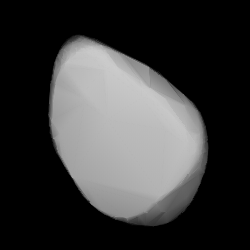Astronomy:9983 Rickfienberg
 Rickfienberg modeled from its lightcurve | |
| Discovery [1] | |
|---|---|
| Discovered by | Dennis di Cicco |
| Discovery site | Sudbury Obs. (817) |
| Discovery date | 19 February 1995 |
| Designations | |
| (9983) Rickfienberg | |
| Named after | Richard Fienberg (astronomer, editor)[2] |
| 1995 DA · 1987 KS2 1993 TS37 | |
| Minor planet category | main-belt · (middle) |
| Orbital characteristics [1] | |
| Epoch 4 September 2017 (JD 2458000.5) | |
| Uncertainty parameter 0 | |
| Observation arc | 30.02 yr (10,963 days) |
| |{{{apsis}}}|helion}} | 3.0191 AU |
| |{{{apsis}}}|helion}} | 2.3962 AU |
| 2.7076 AU | |
| Eccentricity | 0.1150 |
| Orbital period | 4.46 yr (1,627 days) |
| Mean anomaly | 107.42° |
| Mean motion | 0° 13m 16.32s / day |
| Inclination | 8.3223° |
| Longitude of ascending node | 49.216° |
| 7.2821° | |
| Physical characteristics | |
| Mean diameter | 7.444±0.280 km[3][4] 12.18 km (calculated)[5] |
| Rotation period | 5.29616±0.00001 h h[6] 5.2963±0.0001 h[7] |
| Geometric albedo | 0.057 (assumed)[5] 0.167±0.035[3][4] |
| C (assumed)[5] | |
| Absolute magnitude (H) | 13.2[3] · 13.3[1][5] |
9983 Rickfienberg (prov. designation: 1995 DA) is a carbonaceous asteroid from the middle region of the asteroid belt, approximately 10 kilometers (6.2 miles) in diameter. It was discovered on 19 February 1995, by American astronomer Dennis di Cicco at his private Sudbury Observatory (817), Massachusetts, United States.[8] It was named after American astronomer and editor Richard Fienberg.[2]
Orbit and classification
Rickfienberg is a non-family asteroid of the main belt's background population when applying the hierarchical clustering method to its proper orbital elements. The dark C-type asteroid orbits the Sun in the central main-belt at a distance of 2.4–3.0 AU once every 4 years and 5 months (1,627 days). Its orbit has an eccentricity of 0.12 and an inclination of 8° with respect to the ecliptic.[1] The first observation was taken at the Australian Siding Spring Observatory in 1987, extending the asteroid's observation arc by 8 years prior to its discovery.[8]
Naming
This minor planet was named for Richard Tresch Fienberg (born 1956) an American astronomer at Rice and Harvard universities, and a stargazer at his private observatory near Danbury, New Hampshire. He is also an editor of the American amateur astronomer magazine Sky & Telescope, after which the minor planet 3243 Skytel is named.[2] The official naming citation was published by the Minor Planet Center on 1 May 2003 (M.P.C. 48389).[9]
Physical characteristics
Lightcurve
During the asteroid's opposition in November 2011, a rotational lightcurve was obtained from photometric observations at Kitt Peak Observatory. It gave a well-defined rotation period of 5.2963 hours with a high brightness variation of 1.3 in magnitude ({{{1}}}), typically indicating a non-spheroidal shape.[7] This period was also confirmed by remodeled data from the Lowell photometric database in March 2016.[6]
Diameter and albedo
According to the survey carried out by the NEOWISE mission of NASA's Wide-field Infrared Survey Explorer, Rickfienberg measures 7.4 kilometers in diameter and its surface has an albedo of 0.17,[3][4] while the Collaborative Asteroid Lightcurve Link assumes a standard albedo for carbonaceous asteroids of 0.057 and calculates a diameter of 12.2 kilometers, as the lower the body's albedo (reflectivity), the larger its diameter, at a constant absolute magnitude (brightness).[5]
References
- ↑ Jump up to: 1.0 1.1 1.2 1.3 "JPL Small-Body Database Browser: 9983 Rickfienberg (1995 DA)". Jet Propulsion Laboratory. https://ssd.jpl.nasa.gov/sbdb.cgi?sstr=2009983.
- ↑ Jump up to: 2.0 2.1 2.2 Schmadel, Lutz D. (2006). "(9983) Rickfienberg [2.71, 0.11, 8.3]". Dictionary of Minor Planet Names – (9983) Rickfienberg, Addendum to Fifth Edition: 2003–2005. Springer Berlin Heidelberg. p. 49. doi:10.1007/978-3-540-34361-5_396. ISBN 978-3-540-34361-5.
- ↑ Jump up to: 3.0 3.1 3.2 3.3 Mainzer, A.; Grav, T.; Masiero, J.; Hand, E.; Bauer, J.; Tholen, D. et al. (November 2011). "NEOWISE Studies of Spectrophotometrically Classified Asteroids: Preliminary Results". The Astrophysical Journal 741 (2): 25. doi:10.1088/0004-637X/741/2/90. Bibcode: 2011ApJ...741...90M. http://adsabs.harvard.edu/cgi-bin/bib_query?bibcode=2011ApJ...741...90M. Retrieved 1 August 2016.
- ↑ Jump up to: 4.0 4.1 4.2 Masiero, Joseph R.; Mainzer, A. K.; Grav, T.; Bauer, J. M.; Cutri, R. M.; Dailey, J. et al. (November 2011). "Main Belt Asteroids with WISE/NEOWISE. I. Preliminary Albedos and Diameters". The Astrophysical Journal 741 (2): 20. doi:10.1088/0004-637X/741/2/68. Bibcode: 2011ApJ...741...68M. http://adsabs.harvard.edu/cgi-bin/bib_query?bibcode=2011ApJ...741...68M. Retrieved 4 December 2016.
- ↑ Jump up to: 5.0 5.1 5.2 5.3 5.4 "LCDB Data for (9983) Rickfienberg". Asteroid Lightcurve Database (LCDB). http://www.minorplanet.info/PHP/generateOneAsteroidInfo.php?AstInfo=9983%7CRickfienberg.
- ↑ Jump up to: 6.0 6.1 Durech, J.; Hanus, J.; Oszkiewicz, D.; Vanco, R. (March 2016). "Asteroid models from the Lowell photometric database". Astronomy and Astrophysics 587: 6. doi:10.1051/0004-6361/201527573. Bibcode: 2016A&A...587A..48D. http://adsabs.harvard.edu/cgi-bin/bib_query?bibcode=2016A&A...587A..48D. Retrieved 1 August 2016.
- ↑ Jump up to: 7.0 7.1 Tatge, Coty B.; Odden, Caroline, E.; Arion, Douglas N.; Feinberg, Richard Tresch (July 2012). "Spectrophotometric Classification and Lightcurve Analysis of 9983 Rickfienberg". Minor Planet Bulletin 39 (3): 135–136. ISSN 1052-8091. Bibcode: 2012MPBu...39..135T. http://www.minorplanet.info/MPB/issues/MPB_39-3.pdf. Retrieved 23 March 2020.
- ↑ Jump up to: 8.0 8.1 "9983 Rickfienberg (1995 DA)". Minor Planet Center. https://www.minorplanetcenter.net/db_search/show_object?object_id=9983.
- ↑ "MPC/MPO/MPS Archive". Minor Planet Center. https://www.minorplanetcenter.net/iau/ECS/MPCArchive/MPCArchive_TBL.html.
External links
- Richard Tresch Fienberg, Sky & Telescope, 18 July 2006
- My Place in the Dark, by Richard Tresch Fienberg, Sky & Telescope,17 July 2006
- Lightcurve Database Query (LCDB), at www.minorplanet.info
- Dictionary of Minor Planet Names, Google books
- Asteroids and comets rotation curves, CdR – Geneva Observatory, Raoul Behrend
- Discovery Circumstances: Numbered Minor Planets (5001)-(10000) – Minor Planet Center
- 9983 Rickfienberg at AstDyS-2, Asteroids—Dynamic Site
- 9983 Rickfienberg at the JPL Small-Body Database
 |


